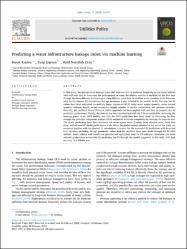| dc.contributor.author | Kızılöz, Burak | |
| dc.contributor.author | Şişman, Eyüp | |
| dc.contributor.author | Oruç, Halil Nurullah | |
| dc.date.accessioned | 2022-03-21T12:48:04Z | |
| dc.date.available | 2022-03-21T12:48:04Z | |
| dc.date.issued | 2022 | en_US |
| dc.identifier.citation | Kızılöz, B., Şişman, E. ve Oruç, H. N. (2022). Predicting a water infrastructure leakage index via machine learning. Utilities Policy, 75. https://doi.org/10.1016/j.jup.2022.101357 | en_US |
| dc.identifier.issn | 0957-1787 | |
| dc.identifier.uri | https://doi.org/10.1016/j.jup.2022.101357 | |
| dc.identifier.uri | https://hdl.handle.net/20.500.12511/9146 | |
| dc.description.abstract | In this study, the infrastructure leakage index (ILI) indicator that is preferred frequently by the water utilities with sufficient data to determine the performances of water distribution systems is modeled for the first time through the three different methodologies using different input data. In addition to the variables in the literature used for the classical ILI calculations, the age parameter is also included in the models. In the first step, the ILI values have been estimated via multiple linear regression (MLR) using water supply quantity, water accrual quantity, network length, service connection length, number of service connections, and pressure variables. Secondly, the Artificial Neural Network (ANN) approach has been applied with raw data to improve the ILI prediction performance. Finally, the data set has been standardized with the Z-Score method for increasing the learning power of the ANN models, and then the ANN predictions have been made by converting the data through the principal component analysis (PCA) method to minimize complexity by reducing the data set size. The model predictions have been evaluated via mean square error, G-value, mean absolute error, mean bias error, and adjusted-R2 model performance scale. When the model outputs obtained at the end of the study are evaluated together with the classical ILI calculations, it is seen that the successful ILI predictions with three and four variables, including the age parameter, rather than six variables, have been made through the PC-ANN method. Water utilities with insufficient physical and operational data for ILI indicator calculation can make network performance evaluations by predicting the ILI through the models suggested in this study with high accuracy in a reliable way. | en_US |
| dc.language.iso | eng | en_US |
| dc.publisher | Elsevier Ltd | en_US |
| dc.rights | info:eu-repo/semantics/embargoedAccess | en_US |
| dc.subject | Artificial Neural Network | en_US |
| dc.subject | ILI | en_US |
| dc.subject | Infrastructure Leakage Index | en_US |
| dc.subject | Machine Learning Solutions | en_US |
| dc.subject | Multiple Linear Regression | en_US |
| dc.subject | Principal Component Analysis | en_US |
| dc.title | Predicting a water infrastructure leakage index via machine learning | en_US |
| dc.type | article | en_US |
| dc.relation.ispartof | Utilities Policy | en_US |
| dc.department | İstanbul Medipol Üniversitesi, Mühendislik ve Doğa Bilimleri Fakültesi, İnşaat Mühendisliği Bölümü | en_US |
| dc.department | İstanbul Medipol Üniversitesi, Rektörlük, İklim Değişikliği Araştırmaları Araştırma Merkezi (İKLİMER) | en_US |
| dc.authorid | 0000-0003-3696-9967 | en_US |
| dc.identifier.volume | 75 | en_US |
| dc.relation.publicationcategory | Makale - Uluslararası Hakemli Dergi - Kurum Öğretim Elemanı | en_US |
| dc.identifier.doi | 10.1016/j.jup.2022.101357 | en_US |
| dc.institutionauthor | Şişman, Eyüp | |
| dc.identifier.wosquality | Q3 | en_US |
| dc.identifier.wos | 000783084300002 | en_US |
| dc.identifier.scopus | 2-s2.0-85125727098 | en_US |
| dc.identifier.scopusquality | Q1 | en_US |


















